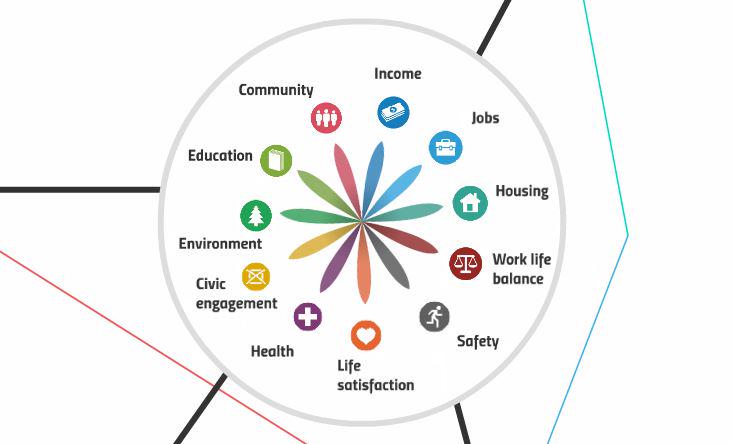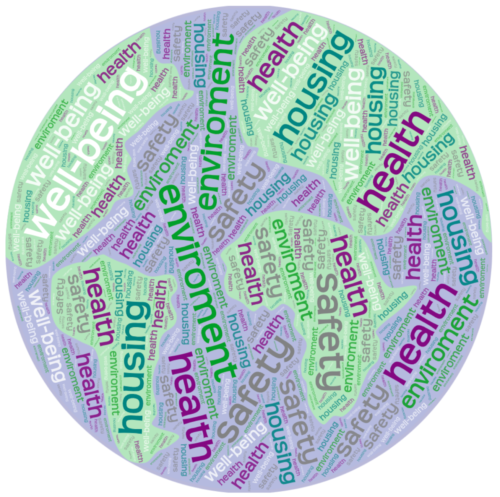The Better Life Index is an index that aims to define and compare the level of well-being of each country, through an interactive tool consisting of key factors. It was drawn up by the Organisation for Economic Cooperation and Development (OECD), that is an international organisation, to which 34 countries belong, and which works to propose better economic policies, starting from the study and analysis of the data.
This index, in detail, takes into account 11 essential themes of life, each of which is based on specific indicators, that are: housing, income, employment, security, social relations, education, the environment, civic engagement, health, satisfaction, security, and work-life balance.
Each theme is represented by a petal of a flower, one for each country and a certain color, and, depending on the importance that a person attaches to the factors, you can detect their performance in different parts of the world.
Housing, for example, that refers to living in satisfactory conditions, is indicated by the color emerald green and is based on three indicators: the incidence of housing expenditure on the net income of households; housing with basic health equipment (the percentage of people with flush toilet all) and the number of rooms per capita, then the rooms present in each house.
Income, on the other hand, that is important for achieving greater prosperity, is represented by the blue and is based on two indicators related to households, which are: net wealth, that represents the average total value of financial assets (savings and shares minus liabilities), and the amount of disposable income, then received, in one year, by deducting taxes.
Then, we find employment, understood as having a job, which is identified by the blue color and is based on four indicators: the employment rate (the percentage of the population who has a paid job); the rate of long-term unemployment (the percentage of individuals who haven’t worked but have been actively seeking a job for more than one year); the average annual compensation of employees for a full-time job and job security (thus a possible loss of income in the event of unemployment).
The indicator on which social relations are based, which refer to contacts with others and are represented with the color fuchsia, however, concerns the quality of the social network, or the percentage of people with friends or relatives on which to rely in case of need.
With regard to education, that is important for the transmission of knowledge, qualifications and skills, which is identified with the light green colour, the indicators taken into account are: the average duration of education in number of years; skills, therefore the results, 15-year-old students, and the level of education, that is the percentage of individuals who have obtained at least one secondary degree (baccalaureate).
As the sixth essential theme, then, we have the environment, the quality of which directly affects the health and well-being of living beings, that is referred to as dark green and is based on water quality, or the percentage of people who claim to be satisfied with it, and air pollution, which affects the average concentration of particulate matter in cities with more than 100,000 inhabitants.
Then, the seventh factor is the civil commitment, which consists in openness and transparency of the Government towards citizens, in order to ensure their trust. It is depicted in yellow and takes into account two indicators: the participation of stakeholders in the regulatory process, thus the level of transparency of public administrations in the drafting of legislation, and the turnout rate of voters registered at the polls, who voted in the last elections.
With regard to health, one of the most important things of all and represented by the purple color, the indicators are the perceived state of health, or the percentage of individuals according to which their health is good, and life expectancy, then the average number of years of a person’s life.
For satisfaction, however, which is very subjective and allows you to compare the quality of life in different countries, the color used is orange and is based on the average perceived level of satisfaction for your life.
Then, we find security, represented by the gray color, which refers to the sense of security related to exposure to risks of physical aggression, crimes, or crimes. It is based on the rate, then the average number of murders per 100,000 people, and the percentage of individuals who claim to feel safe walking alone at night.
Finally, the last theme is work-life balance, represented by red, which consists in finding the right balance between working life and daily life; it is based on the average number of minutes per day devoted to leisure and personal care, and the share of employees who work more than 50 hours a week on average.

MY BETTER LIFE INDEX
Personally, in my Better Life Index, I would have given all topics the utmost importance, as each of them is essential to make our lives better and our well-being higher.
However, on closer reflection, I have understood that there is a very close correlation between them and that, if some of them were very low, others would be more.
So, I decided to give the utmost importance to housing, environment, health and safety. This is because living in satisfactory housing conditions, in a healthy environment, which directly affects health, and without the fear of going out alone, would automatically improve access to education and the labour market, would lead to increased productivity, wealth and life, reduced spending and good social relations.
COMPARISON BETWEEN COUNTRIES
The countries I want to compare with my Better Life Index are Italy, which is over half, Greece, that is under half, and the United States, which is one of the highest.
I choose Italy as the first country because it is the country in which I was born and where I still live today, so I want to know what conditions it actually is in regarding the essential factors of life, based on the importance I have given them.
Then, I chose Greece, as I always wanted to visit it but I never had the opportunity, so I have the curiosity to know better the situation in which it is located.
And, finally, the United States because it has always been my dream to go there and try to do some work experiences, so as to enrich my knowledge, visit new places and, above all, improve my English and start to speak it.
The United States is in better condition on almost all aspects taken into account, so they have the highest degree of well-being among the three; in the second place, however, we find Italy, in which the work balanceLife, health, social relations and safety are above average. Finally, last place is Greece, which in terms of social relations, income, employment and satisfaction is below average.
Silvia Versaci 4E





